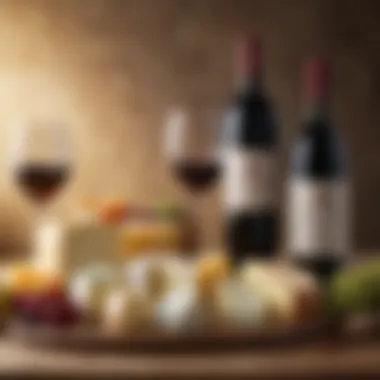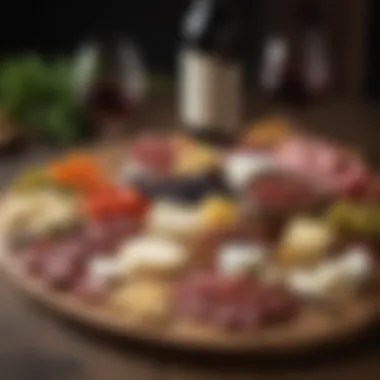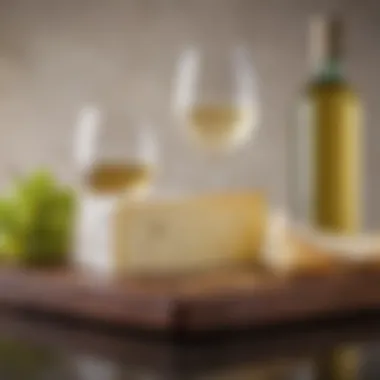The Art of Pairing Cheese and Wine Masterfully


Intro
The relationship between cheese and wine is a classic combination that has evolved through centuries of culinary tradition. Both ingredients possess an exquisite range of flavors and textures, making their pairing an intricate art. This article delves into the nuances of harmonizing cheese with wine, offering insights into the various types of cheeses and wine varieties available. By understanding the foundational principles of pairing, readers can elevate their gastronomic experiences, enhancing both enjoyment and appreciation.
Understanding flavor profiles is essential in achieving an ideal pairing. Each cheese type—whether it be a creamy Brie, a sharp Cheddar, or a pungent Roquefort—produces unique taste sensations when combined with different wines. Wine also comes with its own spectrum, with options ranging from the light and crisp Sauvignon Blanc to the rich and bold Cabernet Sauvignon. The interplay between these two culinary staples can either complement or contrast one another, leading to delightful discoveries or unfortunate mismatches.
This guide serves both novices seeking to enjoy a simple evening with cheese and wine, and seasoned connoisseurs hoping to refine their approach to pairings. Throughout the article, we will explore each aspect carefully, unraveling the complexities that lie within the art of cheese and wine pairing.
"The perfect pairing is not just about flavors; it's about creating an experience that resonates with the palate."
The journey of mastering this art begins with knowing the basics of what cheeses and wines bring to the table. With this understanding, the exploration can proceed to more advanced techniques, ensuring that each dining experience not only satisfies the taste buds but also resonates on a deeper level.
Preamble to Cheese and Wine Pairing
Pairing cheese and wine is more than just a culinary tradition; it is an art that enhances flavor, texture, and overall dining experience. Understanding cheese and wine pairing is essential for food lovers who wish to elevate their tasting adventures. This section will lay the groundwork for the key principles and considerations involved in successful pairings, offering insights into the intertwined histories and cultural significances of these two beloved foods.
A thoughtful pairing can transform a simple meal into a rich exploration of flavor profiles. Each cheese type exhibits unique characteristics that can compliment or challenge a wine’s qualities. Moreover, the benefits of learning about these pairings extend beyond enhancing personal enjoyment; they can also impress guests and elevate social gatherings.
Cultural Significance of Pairings
Globally, cheese and wine have traveled together through history, often reflecting local customs, agriculture, and traditions. In France, for instance, cheese and wine pairings form an integral part of the culinary culture, showcasing regional varieties that have developed over centuries. This harmonious coexistence tells a story of terroir—where a product comes from, how it is made, and its relationship with the surrounding environment.
Pairings can signify social status and heritage. For example, Italian cuisine embraces exquisite pairings that are regionally specific, much like in France. Wine and cheese not only offer sensory pleasure but can also symbolize friendship and hospitality across various cultures, reminding us of both abundance and the simple pleasures of shared meals.
The Science Behind Flavor Compatibility
Understanding the science of flavor compatibility is crucial for achieving delightful pairings. Several factors come into play, primarily the elements of taste including sweetness, acidity, bitterness, and umami.
For example, fat content in cheese interacts differently with wine. Higher fat cheeses, like triple-cream brie, need a wine with enough acidity to cut through richness. Conversely, drier cheeses, such as aged gouda, can be complemented with a sweeter wine like a late harvest Riesling. Recognizing these interactions leads to informed decisions when selecting the perfect wine for cheese.
Moreover, the aromas also contribute to the experience. Scientists explain that our brains perceive aroma compounds in both cheese and wine that can either enhance or lessen the overall tasting experience. Pairings should seek harmony through these aromatic compounds, leading to a balanced and enjoyable profile. The chemistry behind these interactions is an extensive topic and worth exploring for those looking to refine their pairing skills further.
Types of Cheese
Understanding the various types of cheese is crucial for successfully pairing them with wine. Cheese characteristics, flavor profiles, and textures can greatly influence the overall experience of a meal. Each type offers a unique interaction with different wines. Having a thorough grasp of the distinctions among cheese varieties allows one to make informed decisions about which wines to choose, elevating the dining experience.
Fresh Cheese Varieties
Fresh cheeses are known for their mild flavors and creamy textures. They contain a high moisture content and are often unaged. These cheeses do not require fermentation to develop flavor. Popular examples include Ricotta, Mascarpone, and Feta.
When pairing fresh cheeses with wine, the goal is to complement their delicate profiles. A light and crisp white wine like Sauvignon Blanc works well. The citrus notes and acidity in the wine enhance the creaminess of the cheese.
Key Fresh Cheese Types:
- Mozzarella
- Burrata
- Cream Cheese
Choosing the right wine enhances the freshness of these cheeses, making for a delightful culinary experience.
Aged Cheese Varieties
Aged cheeses have complex flavors that develop over time through aging. These cheeses often have lower moisture content, resulting in a firmer texture. Varieties like Cheddar, Gouda, and Parmigiano-Reggiano are well-known aged cheeses.


To pair with these cheeses, one must consider their intensity. A full-bodied red wine like Cabernet Sauvignon complements the richness of Cheddar, while a fruity Merlot can match with creamy Gouda.
- Flavor Depth: Aged cheeses mature in flavors and can offer notes of nuttiness or spice.
- Texture: The texture varies from crumbly to hard, impacting the mouthfeel when paired with wine.
Understanding how aging affects flavor is essential for achieving optimal pairings.
Blue Cheese Profiles
Blue cheeses are characterized by their distinct, bold flavors and their blue veins created by mold cultures. Varieties like Roquefort, Gorgonzola, and Stilton provide a unique tasting experience. The sharpness and saltiness of blue cheese can be quite intense.
When pairing, sweeter wines like Port or Sauternes often balance the saltiness. The sweetness in these wines softens the pungency of the cheese, creating a harmonious blend.
- Notable Blue Cheeses:
- Roquefort
- Gorgonzola
- Stilton
This interaction between sweet wines and blue cheeses showcases how specifying flavors can create novel combinations.
Cheese Texture and Its Importance
Texture plays a vital role in the cheese and wine pairing process. The mouthfeel of cheese influences how it interacts with the wine. Understanding texture helps identify which wines will enhance or contrast the cheese flavor effectively.
Different textures include:
- Soft: Creamy and spreadable, which pairs better with light wines.
- Semi-Hard: Versatile for many wine options, allowing for more creative pairings.
- Hard: Firm and crumbly, often needing robust wines for balance.
By paying attention to texture, one can discover unique pairings that elevate the enjoyment of cheese and wine.
Wine Varieties and Characteristics
Understanding wine varieties and their characteristics is crucial for achieving successful cheese pairings. Different types of wine offer diverse flavor profiles, acidity levels, and aromas, which significantly influence how they interact with various cheeses. Each wine variety brings unique qualities that can either complement or clash with the characteristics of the cheese. Thus, recognizing these distinctions allows for better pairing decisions that enhance the overall dining experience.
Red Wine Categories
Red wine encompasses a wide range of styles, each offering distinct flavors and textures. Common categories include:
- Cabernet Sauvignon: Known for its full body and high tannins, this wine often showcases dark fruit flavors. It pairs well with aged cheeses, such as cheddar or Gouda, due to their robust nature.
- Merlot: This wine is softer with fruity notes and moderate tannins. It complements softer cheeses such as Brie or Camembert, bringing harmony to the palate.
- Pinot Noir: Often lighter in body, Pinot Noir presents a complexity of red fruit flavors. It is versatile and works nicely with a variety of cheeses, including Gruyère and creamy goat cheese.
Each of these red wine types has its nuances, affecting how well it pairs with selections of cheese. When choosing red wine, consider the cheese's intensity and texture to determine compatibility.
White Wine Essentials
White wine varieties also offer a broad spectrum of flavors and aromatic profiles. Essential categories include:
- Chardonnay: This wine can vary from buttery to mineral. Its creamy texture matches well with rich cheeses like triple cream Brie, creating a balanced mouthfeel.
- Sauvignon Blanc: Known for its high acidity and bright citrus flavors, it works well with tangy cheeses like feta or goat cheese. The acidity cuts through the cheese's creaminess, enhancing the experience.
- Riesling: Ranging from dry to sweet, this wine can be very aromatic. It is a good choice for pairing with blue cheeses such as Roquefort. The sweetness of the Riesling offsets the pungent flavors of the cheese effectively.
Exploring different white wines offers home cooks and experts alike new opportunities for perfect pairings.
Sparkling and Dessert Wines
When considering sparkling wines, such as Champagne or Prosecco, the effervescence adds a unique dynamic to cheese pairings. The bubbles can cleanse the palate, allowing for more versatility in pairings. Sparkling wines work well with many cheeses, particularly salty ones like Parmigiano-Reggiano.
For dessert wines, varieties like Sauternes or Port introduce sweetness, often pairing wonderfully with strong or blue cheeses. Their richness contrasts beautifully with the saltiness and bold flavors found in these cheeses.


Pairing the right wine with cheese can elevate the tasting experience, enhancing both the cheese and the wine itself.
Fundamental Pairing Principles
Understanding the fundamental principles of pairing cheese and wine is critical in savoring the best out of both. These principles guide the selection process, ensuring that the flavors resonate well together. When done right, a well-paired cheese and wine can enhance the enjoyment of each other. Knowing these basics allows enthusiasts and casual drinkers alike to explore diverse combinations, creating memorable culinary experiences.
Matching Intensity of Flavors
One of the most vital principles in pairing cheese with wine is matching the intensity of flavors. This principle suggests that a bold, strong cheese should be paired with a similarly intense wine. Conversely, delicate cheeses are better complemented by lighter wines.
For example, robust cheeses like aged Gouda or a strong Cheddar pair well with a full-bodied red wine like Cabernet Sauvignon. Both possess powerful flavors that can stand up to one another without one overpowering the other.
On the other hand, fresh cheeses such as goat cheese or ricotta may be better suited to a crisp Sauvignon Blanc. This wine enhances the flavor without masking the subtleties of the cheese. To make this pairing effective, consider the following aspects:
- Flavor Strength: Assess how bold the cheese or wine is.
- Color: As a general guideline, whites can complement lighter cheeses, while reds pair with bolder options.
- Body: Look at the texture and body of the cheese and wine to find a balance.
Complementing vs. Contrasting Flavors
Complementing and contrasting flavors is another essential principle in pairing cheese with wine. Choosing to complement means selecting pairings with similar flavor profiles. For example, a creamy Brie complemented with a soft Chardonnay works well because they both present smooth, rich profiles.
In contrast, contrasting flavors can create interesting dynamics. A classic pairing involves blue cheeses like Roquefort, which has strong, salty notes, being paired with a sweet dessert wine like Sauternes. Here are some key considerations to navigate this approach:
- Sweetness vs. Saltiness: Sweet wines can balance salty cheeses effectively.
- Acidity: High-acid wines can cut through rich, fatty cheeses, creating a pleasant mouthfeel.
- Earthy Notes: Earthy wines can enhance the complexity of nutty cheeses, like Parmigiano-Reggiano.
"Learning the art of pairing takes practice, but these foundational principles provide a solid starting point for anyone eager to explore the world of cheese and wine."
Common Pairing Examples
The exploration of common pairing examples provides practical insights that enhance the overall understanding of aligning cheese with wine. These pairings are not just about taste; they offer a sensory journey through textures, flavors, and aromas. By examining specific combinations, one can appreciate how different forms of cheese interact uniquely with various wines. This section aims to demystify these pairings, illuminating why certain combinations succeed while others may falter.
Soft Cheeses with Wine
Soft cheeses, such as Brie or Camembert, are characterized by their creamy textures and milder flavors. The richness in soft cheese often pairs beautifully with wines that have a bit of acidity, helping to cut through the fat.
- Brie and Chardonnay is a classic pairing. The buttery profile of Brie complements the oak notes in a good Chardonnay.
- Camembert and Sauvignon Blanc showcases how the herbaceous notes in Sauvignon Blanc can enhance the earthy undertones of the cheese.
When selecting a wine for soft cheeses, consider the cheese's ripeness. A young Brie can be brightened by a crisp white, while a more matured Camembert might pair better with a rounder red.
"The right wine can elevate soft cheese, transforming the dining experience into something exceptional."
Hard Cheeses and their Pairings
Hard cheeses like Parmigiano-Reggiano or aged Gouda possess distinct textures and flavors. These cheeses often have concentrated flavors due to their aging processes. Pairing options here depend on the flavor intensity.
- Parmigiano-Reggiano and Barolo creates a rich palate experience. The savory, nutty notes of the cheese meld with the robust, tannin-filled qualities of Barolo.
- Aged Gouda and Porter can balance the sweet caramel notes found in Gouda with the roasted malt profiles in Porter.
The choice of wine for hard cheeses should reflect their strong and often salty nature. A richer red or a bold lager often works well.
Exploring Blue Cheese Pairings
Blue cheeses, such as Roquefort or Stilton, are known for their sharp and tangy flavors. Their bold presence warrants thoughtful wine selections, generally favoring wines that can harmonize or contrast well.
- Roquefort and Sauternes exemplifies the sweetness of the wine which helps to mellow the assertive saltiness of the cheese.
- Stilton and Port shows how the fruitiness of Port enhances the complexities of the cheese, bringing new dimensions to the combination.


These pairings exemplify the art of contrast. While some cheeses play well with sweet wines, others thrive alongside bolder varieties, often leading to delightful surprises in flavor combinations.
Understanding these common pairings provides a foundation from which cheese and wine lovers can explore more complex combinations and further individual tastes.
Regional Cheese and Wine Pairings
Regional cheese and wine pairings represent a deeper dive into the cultural and geographic nuances that affect flavor profiles. Understanding these pairings enhances not just the gastronomic experience but also connects one to the history and traditions of a place. Each region has distinct agricultural practices, climate, and culinary philosophies, which imprint unique characteristics on their cheeses and wines. Therefore, exploring regional pairings allows the diner to travel through flavors without leaving their table.
Moreover, regional pairings benefit the palate significantly. Pairing local cheeses with wines from the same area often leads to harmonious tasting notes. This is due to the fact that both the cheese and the wine share similar profiles, making them naturally complementary. For example, the lush grass of a region can influence the cow’s milk flavor in the cheese, which may find a delightful balance in wines produced from grapes grown in the same soil.
Considering regional pairings can also make for exciting discoveries. Taste preferences can shift when encountering the distinctive terroirs that define each local product. So, it is advantageous to explore these pairings as they foster appreciation for craftsmanship and connection to geography.
French Cheese and Wine Duo
France is renowned for its outstanding cheese and wine combinations, a result of long-standing traditions. French cheeses, such as Camembert or Roquefort, often find their ideal complements in wines from their respective regions. For instance, Camembert pairs beautifully with a soft, fruity Normandy cider or a light Chardonnay. They enhance the creamy texture without overpowering the gentle flavors.
On the other hand, the sharpness of Roquefort finds balance with a rich Sauternes. The sweetness of the wine offsets the pungency, creating a pleasing contrast. Overall, the philosophy of pairing in France emphasizes locality and the celebration of artisanal cheeses and correspondingly crafted wines, which combine to elevate regional pride.
Italian Culinary Harmony
Italy showcases a tapestry of regional pairings, each reflecting the country’s diverse landscapes and culinary traditions. Take Parmesan, for example; this hard cheese pairs excellently with a bold Chianti. The wine’s acidity complements the cheese’s nutty characteristics, offering a beautifully balanced profile.
In contrast, a gorgonzola enjoys a good match with Moscato d'Asti, where the sweetness in the wine cuts through the cheese’s rich creaminess.
Italy also experiments with food pairings beyond traditional matches. Often, local wines are encouraged to be paired with cheese from neighboring regions, providing a unique culinary journey that balances mutual flavors and textures.
New World Combinations
New World regions, like California and Chile, provide fresh takes on cheese and wine pairings. They often draw from traditional European influences while introducing local innovations. For instance, California’s Goat cheese pairs impressively with a Zinfandel. The cheese's tangy profile harmonizes with the jammy notes of the wine. In contrast, a creamy Brie from a New Zealand winery complements various Pinot Noirs, which bring irresistible berry nuances to the pairing.
It is important to note that New World regions tend to adopt a more experimental approach. This attitude often results in unexpected combinations that surprise the palate while still embodying a balance between the food and wine.
Exploring the best regional cheese and wine pairings is a delightful journey that can expand your culinary horizon.
Ending and Final Thoughts
Exploring the pairing of cheese and wine offers a deeper understanding of flavor dynamics within culinary arts. This article highlights the various dimensions of pairing, emphasizing the essential guidelines, types of cheese, and characteristics of wine. Each aspect plays a critical role in making informed choices that enhance the dining experience.
Understanding why certain flavors complement or contrast with each other can provide insight into personal preferences and cultural nuances. As readers learn these practical principles, they gain valuable tools to elevate their culinary skills. This approach not only enriches everyday meals but also promotes social gatherings centered around thoughtful food experiences.
"A well-paired cheese and wine can turn a simple meal into a memorable experience."
Furthermore, the journey involves assessing factors such as texture, wine body, and the inherent strength of flavors. The conclusion stresses the importance of being mindful when making selections, encouraging discernment, yet remaining open to the unexpected. With practice, individuals can refine their palate and develop confidence in mixing these two timeless culinary delights.
The Journey of Discovery in Pairing
The exploration of cheese and wine pairing is not merely about guidelines or rules; it is an art of discovery. Each tasting presents opportunities to learn and adapt preferences. The subtlety of flavors in both cheese and wine invites a journey unlike any other in the culinary realm.
Engaging with different regions and varieties allows individuals to uncover unique combinations that resonate with personal tastes. Whether it’s the creaminess of Brie paired with a light Chardonnay from California or a bold Roquefort reassuringly matched with a sweet Sauternes, the options are abundant.
Moreover, the variations in production methods contribute significantly to how these items interact. Aging processes, for instance, impart distinct textures and flavors that can align surprising well. Exploring these nuances adds layers to appreciation and enjoyment.
Encouragement for Personal Experimentation
Experimenting with cheese and wine pairings can open doors to new culinary horizons. Readers are encouraged to approach pairing as a playful exploration rather than a rigid protocol. Every individual's palate is unique, and what works for one may not work for another.
Start by combining familiar choices, and gradually introduce less familiar types. Maintain an open mind and take notes on experiences. Simple acts, like hosting a tasting night with friends, can create interactive learning environments conducive to discovery.
In summary, the pairing of cheese and wine is a journey of personal taste exploration, steeped with cultural significance. The essence lies in enjoying the process, embracing trial and error, and ultimately finding a personalized balance that resonates well. Through thoughtful experimentation, culinary artistry flourishes, yielding not just successful pairings, but also lasting memories.







